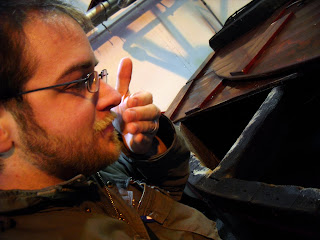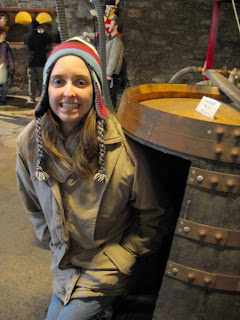Anyway, the Aberfeldy distillery is one of the main suppliers for Dewar's, one of the world's best-selling brands of blended whisky, and is also home to the Dewar's World of Whisky museum, which explores both the history of the company and the history of the drink. At only GBP 6.50 for the museum, the distillery tour, and a complimentary dram of the good stuff, the place is an absolute steal.
So how is whisky made, you ask? Well, it starts out a lot like beer. You start with some kind of grain, usually malted barley, sometimes dried over a peat fire.
Then you grind the malt and mix it with hot water (aka, "mash" it) to break down the starches in the malt. This produces wort, which is mostly sugar. It's also one of two places in Scotland that's actually warm.
The next step is to cool the wort down and add yeast, so that the sugars in the wort can be turned into alcohol through fermentation. This happens in a magical happy place called the "tun room," where the fermenting wort is stored in giant wooden vats.
The fermentation process produces a lot of carbon dioxide, so if you spend a couple minutes in the tun room, you get a little tipsy from lack of oxygen.
The fermentation process also smells amazing. Kind of like a strong Belgian beer or a really nice barley wine, which is essentially what the wort is at this point.
(Note from Nana: Why is Justin smelling his hand? Actually, he's not. The gas produced by the fermentation process is heavier than air, meaning that you can scoop up a handful of it and carry it out of the tun and to your nose. Imagine scooping up water in your palm to wash your face, and you know what he's doing here. It's just that what he's scooping is invisible, so he looks a bit kooky doing it)
This is the other part of Scotland that's warm.
During the distillation process, all the partially-distilled spirits are kept under lock and key because of the strict duty controls imposed on distilling by the taxman.
If you look closely, you may notice that the stuff flowing through this final spirit safe is clear. All whisky is clear to begin with--it gets its color from the maturation process, during which the whisky is stored in oak barrels for anywhere from six years to several decades.
The type of barrel used has a major impact on the flavor of the whisky. Most Scottish distilleries mature their spirits in used American bourbon casks, which is one reason why the oak flavor is so much stronger in American whiskies.
Sometimes, sherry casks are also used.
(Note from Nana: Being patriotic, we of course enquired about the causes of the popularity of American barrels. Sadly, it's entirely economic. Used American bourbon barrels are much cheaper than the sherry barrels, which come from Spain - I don't recall the exact numbers, but it's something like a fourth or less of the cost. Bourbon barrels are plentiful because under bourbon distilling regulations, they can only be used once. Whisky gets another 2-3 uses out of the same barrel. Due to different brewing volumes, they do have to disassemble and reconstruct the barrels for whisky).
At the end of this maturation process, what you have is a single-malt whisky. That means all the whisky in the barrel was made in the same batch in the same distillery using malted barley and no other grains. Such whiskies are normally simply branded by distillery: Aberfeldy, in this case; or Glenfiddich, Balvenie, Glenmorangie, and Macallan, just to name a few of our favorites. (It turns out that, except for Glenmorangie, all of those are from the Speyside region.)
But single-malt whiskies can also be used to make blended whisky, which, like Dewar's, are usually branded under a separate name.
Single-malt whiskies are kind of like microbrewed beers in that the flavor can vary from batch to batch. Blended whiskies try to achieve the same flavor in every batch by mixing a base of grain whisky (which substitutes cheaper grain for some of the barley used in malt whisky) and a variety of malt whiskies.
The replica blender's workshop is like a wunderkammer of booze, containing samples of multiple batches and products from nearly every available provider.
(Note from Nana: Or at least it would have been, if there were anything in the bottles. Alas, they were merely tinted glass.)
The final product is branded with (surprise!) a Highland soldier. The only other options, I think, would have been a thistle, Walter Scott, or Robert Burns.
So at the end of the tour, you get to try some of the stuff. And if you're really nice, really curious, and really indecisive, you might even get an extra taste, like we did!
Below, from left to right, are an Aberfeldy single-malt, a Dewar's 12-year blended, and the classic Dewar's white label, which is the company's top seller. The black jug in the back is water: the preferred method of serving whisky in Scotland is either neat, or with a few drops. It seems they only offer you ice if you order your drinks with an American accent.
As Nana demonstrates here, the real flavor of whisky is actually in the smell--the vanilla-like smell from the oak casks, leather, peat, smoke, flowers.
So that's Scotch whisky, in a nutshell.
BONUS LESSON: Why "whisky"? I always thought it was "whiskey," then I learned that "whiskey" was adopted as the spelling outside of Scotland in the late-18th, early-19th century because Scottish whisky was so infamously unpalatable.
Yep, that's right: Scotch whisky as we know it, like a lot of other products that trade on antique nostalgia, was a Victorian invention. Doesn't make it any less delicious, though!



















